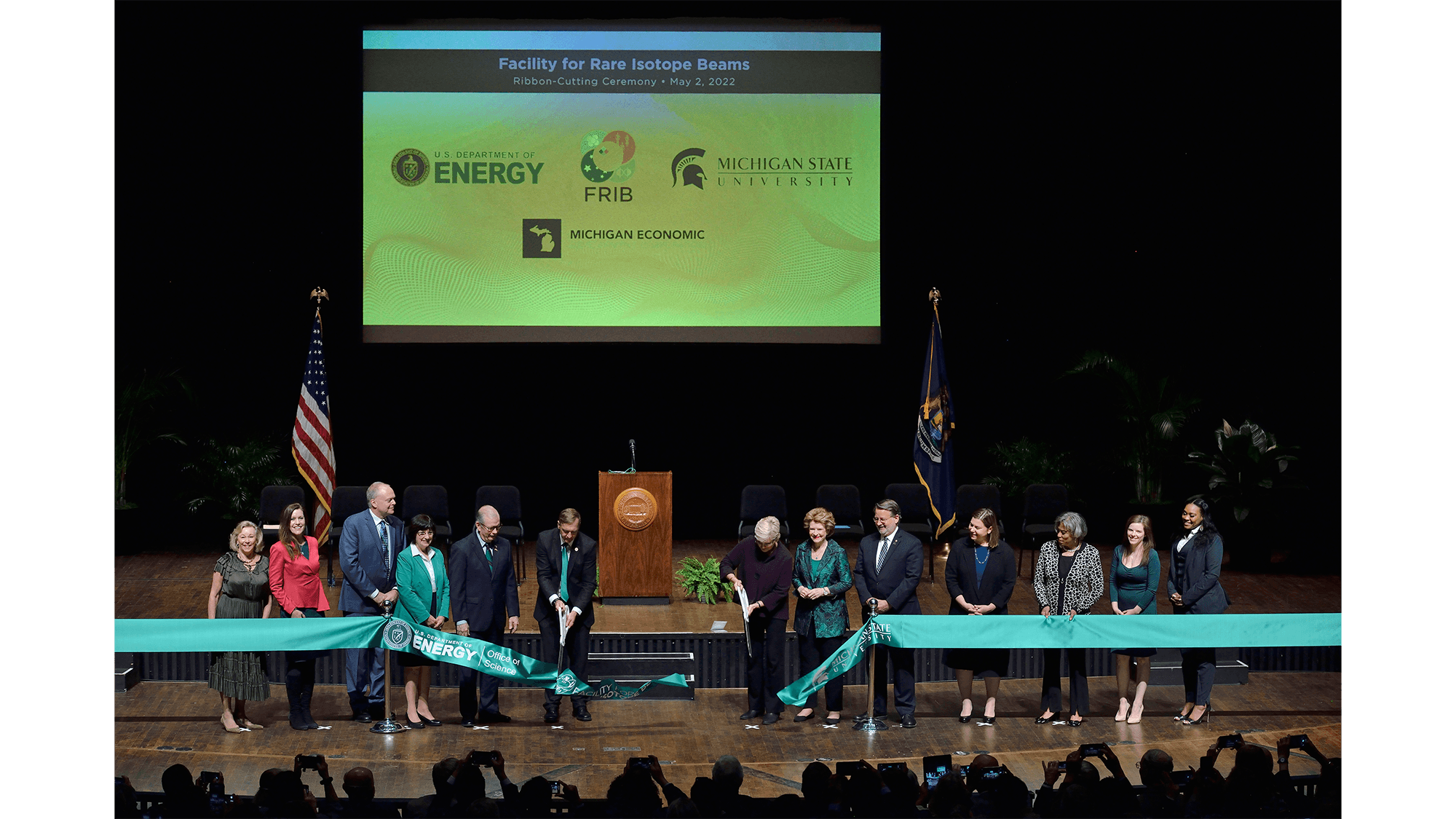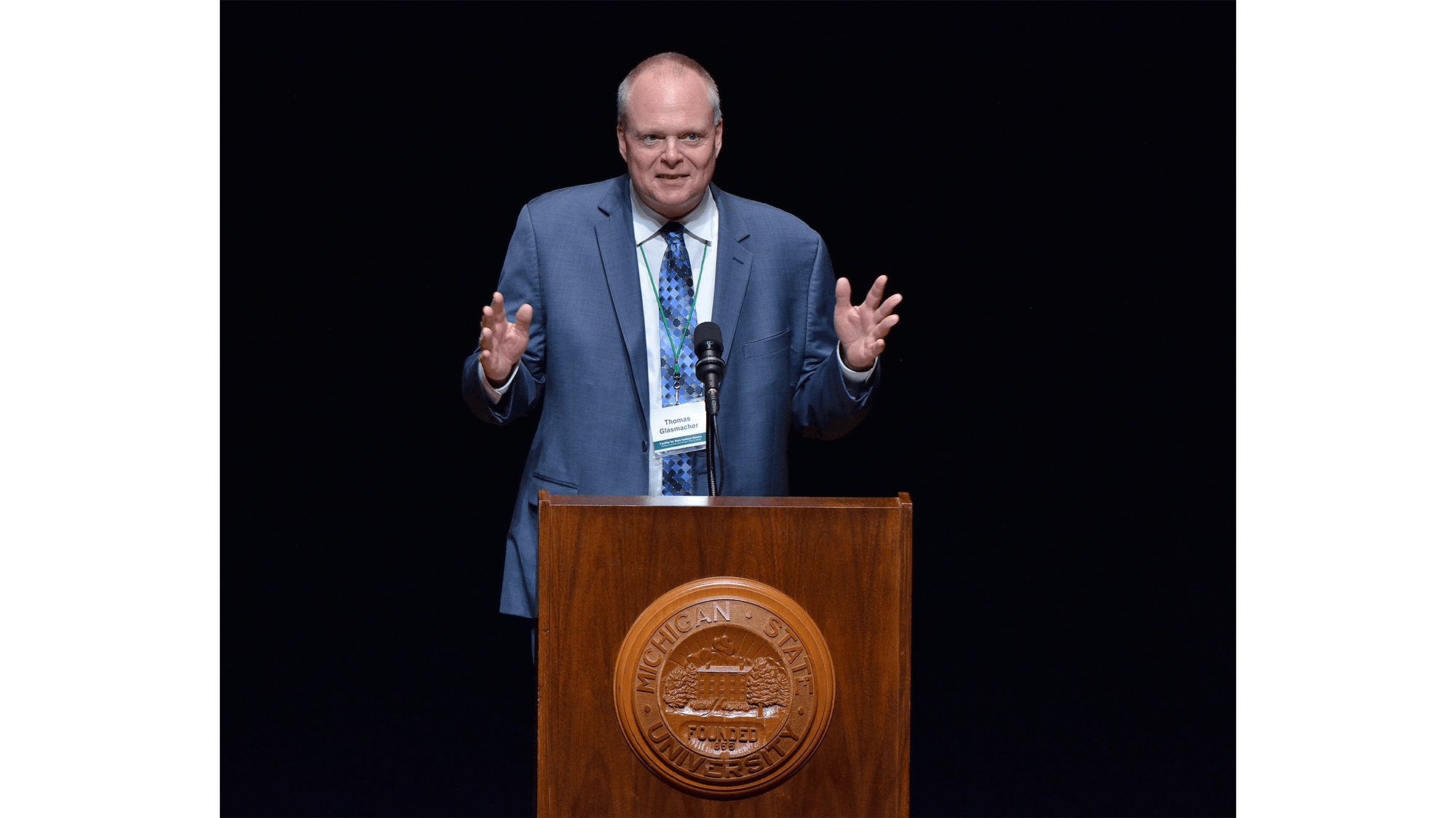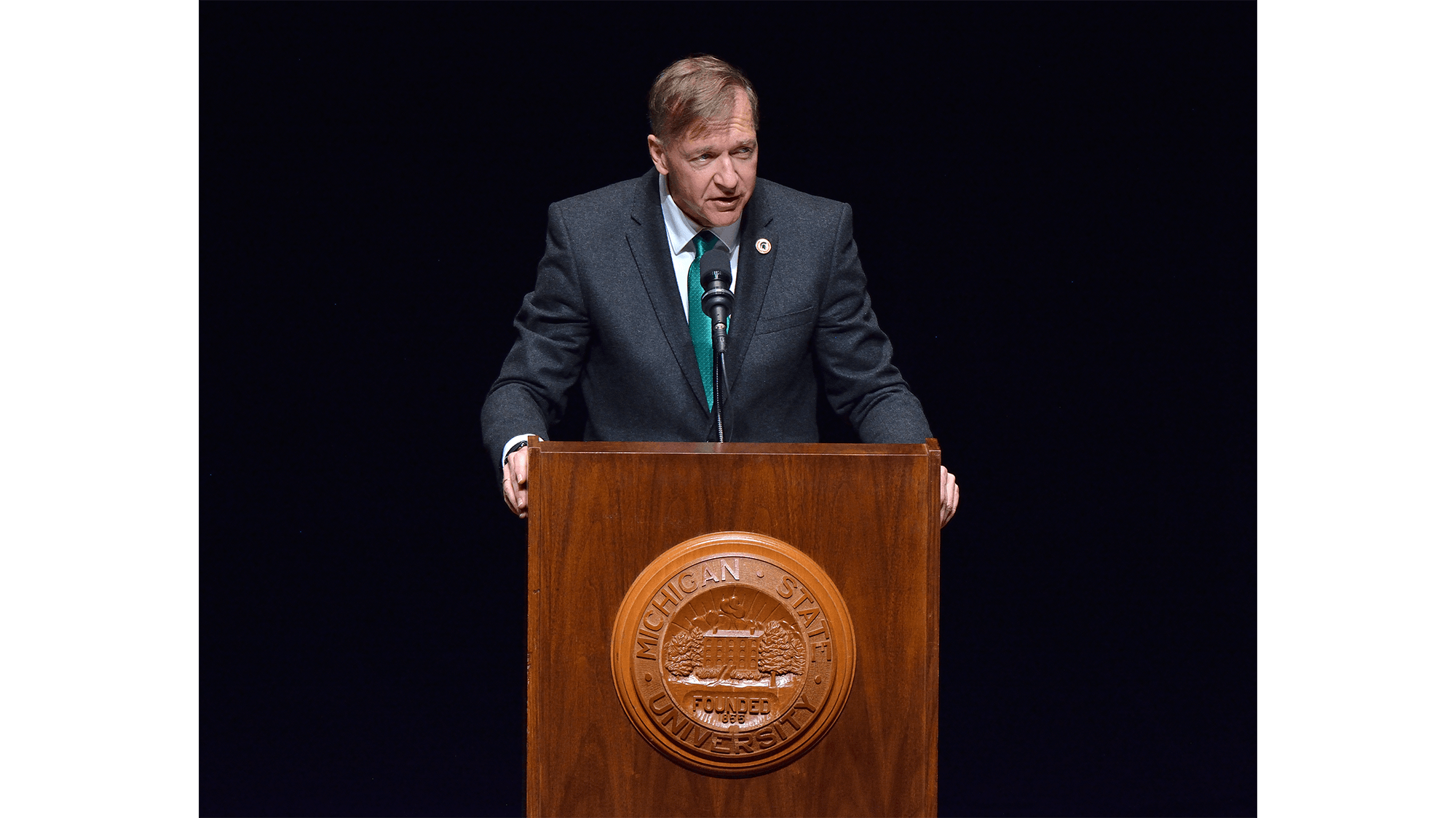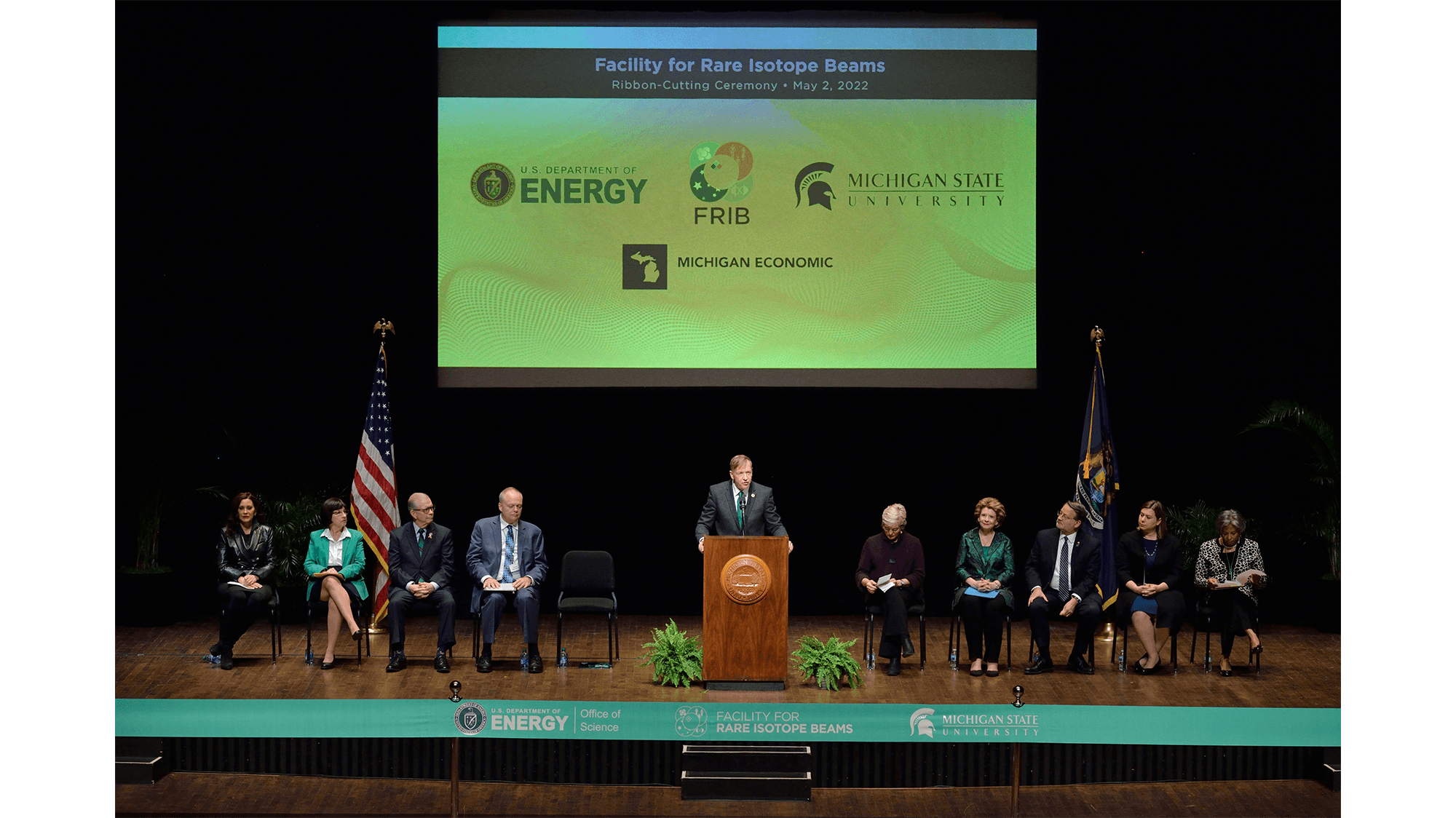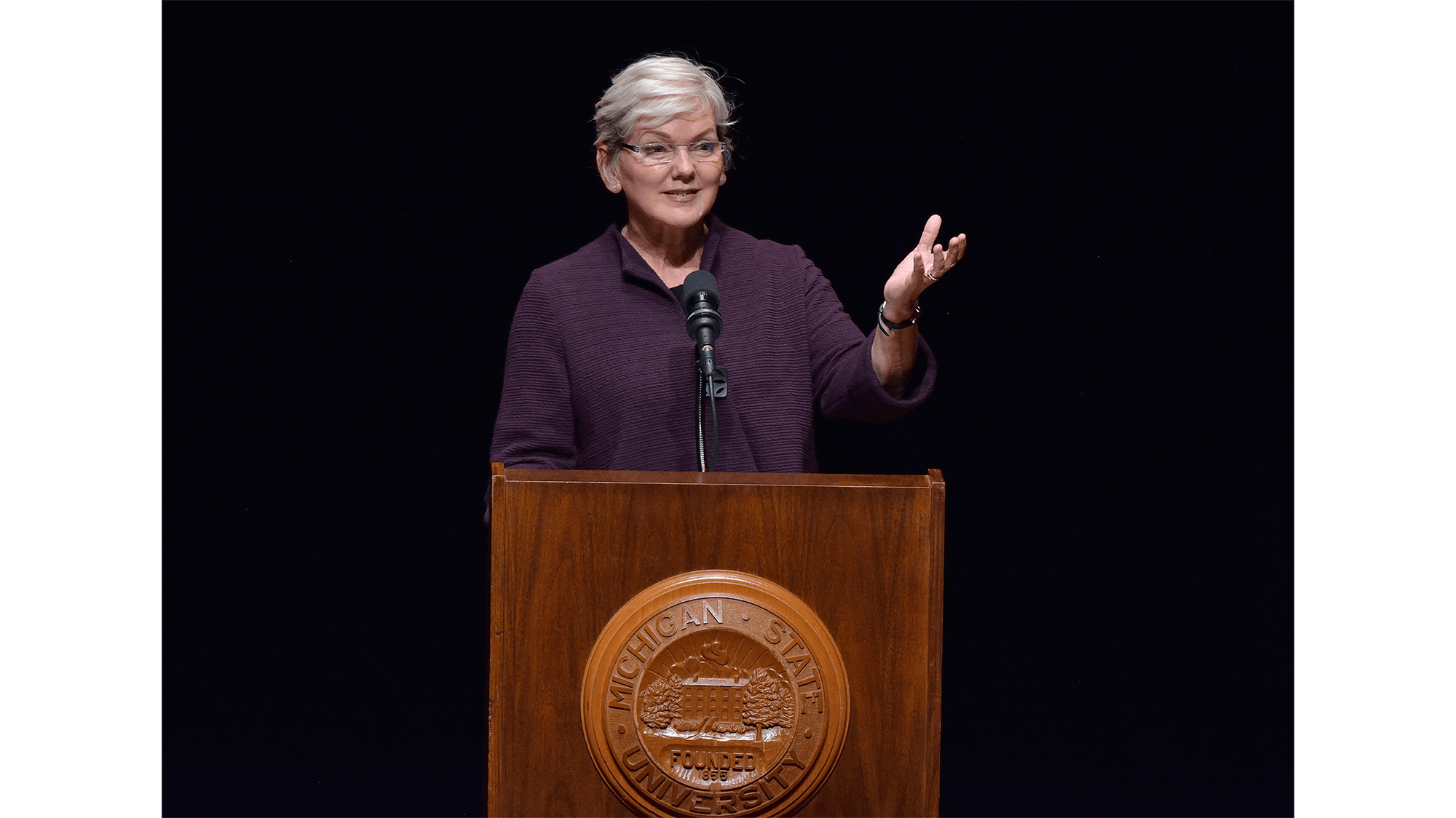Michigan State University’s Facility for Rare Isotope Beams (FRIB), a user facility for the U.S. Department of Energy Office of Science, opened its doors to discovery with a ribbon-cutting ceremony on 2 May. U.S. Secretary of Energy Jennifer M. Granholm and MSU President Samuel L. Stanley Jr., M.D., cut the ribbon to officially mark the start of FRIB’s scientific mission.
“Returning home to Michigan to unveil the FRIB—which began construction when I was Governor—is a testament to the hard work that it took to get to this point and the pivotal role this facility will play in making America the global leader in rare isotope nuclear science research,” said U.S. Secretary of Energy Jennifer M. Granholm. “Along with boosting the nation’s innovative capacity and global competitiveness, this facility will help us discover new things about our universe and ourselves, find new ways to diagnose and treat cancer, and strengthen our national security.”
In addition to Granholm and Stanley, those who participated in the ribbon-cutting event included:
- Michigan Governor Gretchen Whitmer
- MSU Board of Trustees Chair Dianne Byrum
- U.S. Representative Tim Walberg
- U.S. Representative Brenda L. Lawrence
- U.S. Representative Elissa Slotkin
- U.S. Senator Gary Peters
- U.S. Senator Debbie Stabenow
MSU Board of Trustees who participated in the ribbon-cutting event included:
- Dianne Byrum
- Melanie Foster
- Kelly Tebay
- Rema Vassar
- Renee Knake Jefferson
About 900 guests attended the ribbon-cutting to celebrate FRIB officially opening for scientific research. FRIB was completed in January, ahead of schedule and on budget. FRIB’s first scientific-user experiments start on 9 May.
Michigan’s elected officials at the federal and state level have been strong advocates for FRIB.
“FRIB will house a world-class research, teaching, and training center to ensure Michigan can continue attracting and developing the best STEM talent in the world,” said Michigan Governor Gretchen Whitmer. “As a Spartan, I am so proud to see MSU investing in its extraordinary students and building more advanced facilities as we continue growing Michigan’s economy. FRIB’s next-generation experiments will bolster Michigan’s talent pipeline and ensure our state is home to high-tech innovation for generations to come.”
FRIB will house the world’s most powerful heavy-ion accelerator, allowing researchers to access more than 1,000 new rare isotopes, many never before produced on Earth. Supporting a community of 1,600 scientists from around the world, FRIB enables scientists to make discoveries about how the universe formed, while advancing innovation in medicine, nuclear security, environmental science and more.
“FRIB is the latest example of MSU’s continued national and international leadership in areas that advance discovery,” said MSU President Samuel L. Stanley Jr., M.D. “The university’s contributions in nuclear science, medicine, education, agriculture, plant science, supply chain and other areas have transformed lives in communities around the world and continue to have a positive impact on people and the planet.”
The accelerator at FRIB propels atomic nuclei of any stable element to half the speed of light, resulting in collisions that produce rare isotopes that, until now, were only found in the cosmos.
Rare isotopes are versions of elements with a number of neutrons that do not hold together forever with the number of protons that define the element. To create rare isotopes at FRIB, a powerful beam of stable isotopes is sped up to half the speed of light and collided with a target, producing rare isotopes.
“We are humbled by the public trust and support over the past 13 years as we have delivered this unique user facility for the Department of Energy Office of Science. Today we celebrate the start of FRIB’s science mission,” said FRIB Laboratory Director Thomas Glasmacher. “We are grateful to our partnerships that have gotten us to this day and are eager to support our scientific user community in making discoveries at FRIB.”
Doors to discovery
Producing rare isotopes at FRIB also leads to scientific discoveries that are bound to change society and improve lives. Nuclear science research already has led to the development of technologies such as MRI and PET scans, smoke alarms and cell phone technology. Additional breakthroughs in nuclear science are expected to yield further improvements in agriculture, environmental studies and many other fields.
Rare isotopes may also be used to research and develop new materials for everything from pharmaceuticals to alternative energy and fuel sources. And on the nuclear security front, FRIB scientists are able to study rare isotopes to further understanding of nuclear reactions without the need for weapons testing.
One of the most immediate areas of potential impact is medicine. Breakthroughs in cancer medicine could be on the horizon. Doctors already use radioisotopes to find malignant cancer cells in PET scans. But medicine has yet to tap into the full potential of rare isotopes to seek out and attack certain cancers in the body. Malignant cells can accumulate elements, like copper, and rare isotopes can help chemists and clinicians track them down.
Decades of experience
MSU has been a site of scientific discovery and a worldwide leader in nuclear science for more than half a century. The National Superconducting Cyclotron Laboratory, a National Science Foundation user facility, and its predecessors have operated until 2022 for more than 40 years at MSU. FRIB looks beyond NSCL’s discoveries to envision the next-generation technology needed for next-generation rare isotope experiments.
Additionally, the university has been home to the No. 1-ranked graduate program in nuclear physics since 2010 and educates about 10% of the nation’s doctoral students in nuclear physics.
Additional quotes of support
“I’m excited to see the amazing scientific breakthroughs this facility will make right here in Michigan. I was here when we broke ground in 2014 – I still have my shovel! We’ve worked together to make sure the project has received the funding it needed to get us to today,” said U.S. Senator Debbie Stabenow. “This facility will help keep the United States at the forefront of nuclear physics and advance our national security. And all this science provides a huge boost to Michigan’s economy. As a proud MSU graduate I’m thrilled that my alma mater is training the next generation of nuclear experts.”
“The FRIB is a world-class facility that will further put MSU – and our state – at the forefront of innovation and discovery. I’ve been proud to have secured the necessary federal support over the years to help complete the FRIB and make this incredible facility a reality,” said U.S. Senator Gary Peters. “The work that will be done at the FRIB is a major national priority – and I’m excited to see what comes next. I look forward to working with MSU to further strengthen Michigan’s economy and support new research and development.”
“The beginning of FRIB operations is a landmark moment for MSU and the entire Greater Lansing area. On top of bringing hundreds of jobs to our community, FRIB positions mid-Michigan for scientific breakthroughs, new investment and a host of international collaborations,” said U.S. Representative Elissa Slotkin (MI-08). “From nuclear security and engineering to environmental science and medicine, there are so many groundbreaking implications for this effort, and I’m grateful to the team at MSU who have been such terrific partners with my office as we’ve worked to secure federal funding to make today possible. This is a milestone that’s going to attract scientists, students, businesses and economic development to Michigan.”
“FRIB, the world’s premier rare isotope beam facility, is nothing short of historic. It is a testament to the immense talent, innovative spirit, and forward thinking that we have here in Michigan,” said U.S. Representative Brenda Lawrence (MI-14). “As the Vice Chair of the House Appropriations Committee, I’m proud to have worked with my Democratic and Republican colleagues to get the federal funding needed for this cutting-edge facility. FRIB will ensure we reach new heights and make ground-breaking scientific discoveries that will affect everything from national defense to the fight against cancer.”
“With this Facility for Rare Isotope Beams for the U.S. Department of Energy at Michigan State University, we are creating jobs today and laying claim to Michigan’s economic future as a destination for investment and innovation. I am proud to have supported this project, and I will continue working in Congress to advance scientific research in Michigan,” said U.S. Representative Dan Kildee (MI-05).
“What an exciting day, that was years in the making, to see the ribbon-cutting of the Facility for Rare Isotope Beams,” said U.S. Representative Tim Walberg (MI-07). “This esteemed research facility will attract the best and brightest from all over the globe to Michigan State to advance innovation and scientific discovery. I have no doubt the research breakthroughs developed here will benefit our society—impacting science, medicine, our economy, and more—in incredibly powerful ways.”
"The opening of the FRIB offers truly one-of-a kind learning experiences for the next generation of scientists and Spartans," said MSU Board Chairperson Dianne Byrum. "It’s exciting to see this facility fully open and it signals to the nation that Michigan State University is a place of excellence and discovery.”
“A warm congratulations to every member of the FRIB team for this on-budget, under-time accomplishment. Operating FRIB will assure continued U.S. leadership in key areas of discovery science and technology, including nuclear science, radiochemistry and accelerator science. They and we can all be proud of this important step forward,” said Brookhaven National Laboratory Director Doon Gibbs.
“The continued dedication of the FRIB team has resulted in this hard-earned success. FRIB’s scientific mission, which now begins, enables exciting new research that was not possible prior to the completion of FRIB,” said Lawrence Berkeley National Laboratory Director Michael Witherell.
“Congratulations from all of us at SLAC. We look forward to working with FRIB to advance superconducting accelerator research and technology and to our partnership on the LCLS-II-HE project going forward,” said SLAC National Accelerator Laboratory Director Chi-Chang Kao.
“This is an important moment for not only FRIB, but also for the nation. FRIB will provide a key capability to the Office of Science and support the development of the next generation of U.S. science and technical workforce,” said Thomas Jefferson National Accelerator Facility Director Stuart Henderson.
###
Michigan State University (MSU) operates the Facility for Rare Isotope Beams (FRIB) as a user facility for the U.S. Department of Energy Office of Science (DOE-SC), supporting the mission of the DOE-SC Office of Nuclear Physics. The establishment of FRIB was funded by DOE-SC, MSU and the State of Michigan, with user facility operation supported by the DOE-SC Office of Nuclear Physics.
The U.S. Department of Energy Office of Science is the single largest supporter of basic research in the physical sciences in the United States and is working to address some of today’s most pressing challenges. For more information, visit energy.gov/science.
Michigan State University has been working to advance the common good in uncommon ways for more than 165 years. One of the top research universities in the world, MSU focuses its vast resources on creating solutions to some of the world’s most pressing challenges, while providing life-changing opportunities to a diverse and inclusive academic community through more than 200 programs of study in 17 degree-granting colleges.
